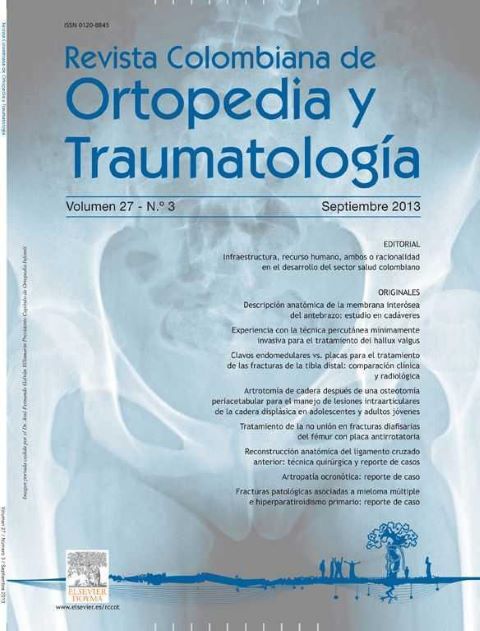Management of diaphyseal femur fracture non-union with an antirotatory plate osteosynthesis
DOI:
https://doi.org/10.1016/S0120-8845(13)70013-0Keywords:
femoral fractures, fractures, non-union, fracture fixation, intramedullary, bone nails, bone transplantation, fracture healing, retrospective studies, evidence level: IVAbstract
Introduction: Every year, there are 250 patients admitted with femoral shaft fracture at our institution. For patients treated with reamed and locked femoral nails, the non-union rate is between 10 to 15%, similar to worldwide incidence. Treating non-union is a challenge because healing rates are of only 50–80% with actual techniques. A novel technique is presented: augmentation with an antirotatory plate.
Materials and methods: We conducted a case series study at two university hospitals, collecting information from patients with diaphyseal femur fracture non-union, treated with antirotatory plate and bone grafts between 1997 and 2008. Clinical and radiological variables were assessed.
Results: 47 patients entered the study, with 48 nonunion fractures of the femoral shaft that had been treated with reamed intramedullary interlocking nail. 30 fractures (62%) had required an open reduction. The average age was 37 years. 44 fractures (92%) healed 6 months after treatment with antirotatory plate and autologous bone grafts.
Discussion: This method promotes both biology and mechanics in the fracture site, allowing bone healing and return to normal activities in a high percentage. We recommend it for the treatment of femoral non-union. Further prospective research may confirm the safety and effectivity of this treatment.
Downloads
References
Villanueva E, Sanguesa MJ. Refractura Femoral en un miembro poliomielitico port ador de un clavo intramedular. Avances Traum. 2003;33(1):60-61
Schat zker J, Tile M, edit ores. The rat ionale of operat ive fracture care. 2.ª ed. New York: Springer; 1998.
Canale ST. Campbell cirugía ortopédica. 10.ª ed. Barcelona: Elsevier; 2004.
Malagón V, Sot o D. Compendio de ort opedia y fract uras. Bogotá: Editorial Médica Celsus; 1994.
Banaszkiewicz PA, Sabboubeh A, McLeod I, Maffulli N. Femoral exchange nailing for aseptic non-union: not the end to all problems. Injury. 2003;34(5):349-56. https://doi.org/10.1016/S0020-1383(02)00191-2
Kanakaris NK, Lasanianos N, Calori GM, Verdonk R, Blokhuis TJ, Cherubino P. Application of bone morphogenetic proteins to femoral non-unions: A 4-year multicenter experience. Inj ury. 2009;40 Suppl 3:S54-61. https://doi.org/10.1016/S0020-1383(09)70013-0
Megas P, Syggelos SA, Kontakis G, Giannakopoulos A, Skouteris G, Lambiris E. Int ramedullary nailing for t he t reat ment of asept ic femoral shaft non-unions aft er plat ing failure: Effectiveness and timing. Injury. 2009;40(7):732-7. https://doi.org/10.1016/j.injury.2008.11.008
Furlong AJ, Giannoudis PV, DeBoer P, Matthews SJ, MacDonald DA, Smit h RM. Exchange nailing for femoral shaft asept ic non-union. Injury. 1999;30(4):245-9. https://doi.org/10.1016/S0020-1383(99)00073-X
Lynch JR, Tait sman LA, Barei DP, Nork SE. Femoral nonunion: risk factors and treatment options. J Am Acad Orthop Surg. 2008;16(2):88-97. https://doi.org/10.5435/00124635-200802000-00006
Brinker MR, O'Connor DP. Exchange nailing of united fractures. J Bone Joint Surg. 2007;89:177-88. https://doi.org/10.2106/JBJS.F.00742
Ueng SW, Chao EK, Lee SS, Shih CH. Augment at ive plat e fixat ion for t he management of femoral nonunion aft er intramedullary nailing. J Trauma. 1997;43:640-4. https://doi.org/10.1097/00005373-199710000-00013
Ueng SW, Shih CH. Augment at ive plat e fixat ion for t he management of femoral nonunion with broken interlocking nail. J Trauma. 1998;45(4):747-52. https://doi.org/10.1097/00005373-199810000-00021
Martínez RA, Alegría VC. Evaluación del trat amiento de las fracturas diaÞ sarias del fémur con clavo bloqueado. Rev Col Or Tra. 2001;15(2):31-8.
el Moumni M, Leenhout s PA, t en Duis HJ, Wendt KW. The incidence of non-union following unreamed int ramedullary nailing of femoral shaft fract ures. Inj ur y. 2009;40(2): 205-8. https://doi.org/10.1016/j.injury.2008.06.022
Downloads
Published
How to Cite
Issue
Section
License
Copyright (c) 2024 Revista Colombiana de ortopedia y traumatología

This work is licensed under a Creative Commons Attribution 3.0 Unported License.

| Article metrics | |
|---|---|
| Abstract views | |
| Galley vies | |
| PDF Views | |
| HTML views | |
| Other views | |




